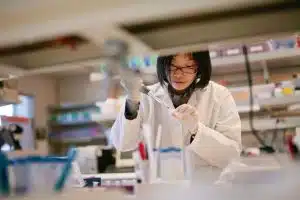MIT Curriculum
Massachusetts Institute of Technology (MIT) has held its breath-taking prestige since its inception in 1861 due to its groundbreaking studies in physical sciences and engineering. However, their innovative curriculum structure has been equally as influential.
Understanding the Structure of MIT’s Curriculum
The curriculum at MIT works on a unique framework crafted to create an environment of challenge and exploration for its students. The structure is divided into three main components: core requirements, major programs, and elective courses.
The Core Requirements
Core requirements at MIT form the foundational knowledge that every MIT student must acquire. They are a mix of science subjects like Mathematics, Physics, Biology, and Chemistry along with humanities, arts, and social science subjects. This ensures comprehensive academic development.
Regardless of their future major, each student must complete these core courses. These are pivotal in ensuring all students receive a well-rounded education, bridging the gap between science and humanities.
The core requirements are designed to give students a strong foundation in critical thinking, problem-solving, and communication skills. Through mathematics courses, students develop logical reasoning and analytical abilities. The science subjects foster an understanding of the natural world and scientific principles. Including humanities, arts, and social science subjects encourages students to think critically about societal issues, cultural diversity, and ethical considerations.
The Major Programs
At MIT, students can choose from an extensive array of significant programs. These range from traditional areas such as mechanical engineering and physics to innovative fields like media studies and cognitive sciences.
Each major program comprises a rigorous, carefully curated set of courses catering to the chosen field’s multifaceted areas. This allows for a deep understanding and knowledge of the subject, equipping the students with the expertise they need for their future careers.
MIT’s major programs are designed to provide students with a comprehensive education in their chosen field. The curriculum includes a combination of theoretical knowledge and practical application. Students engage in hands-on projects, research opportunities, and internships to gain real-world experience and develop problem-solving skills. The major programs also emphasize collaboration and teamwork, preparing students for modern work environments’ dynamic and interdisciplinary nature.
The Elective Courses
Beyond the core requirements and major programs, MIT offers a broad selection of elective courses. This curriculum component allows students to explore their interests, including foreign languages, art, music, and even robotics.
MIT’s elective courses are designed to encourage students to pursue their passions and explore new areas of interest. The diverse elective options allow students to customize their education and tailor it to their unique goals and aspirations. Whether learning a new language, delving into the world of art, or diving into the exciting field of robotics, these elective courses provide students with a well-rounded education beyond their major program.
Furthermore, the elective courses at MIT often incorporate interdisciplinary approaches, allowing students to connect different fields of study and develop a broader understanding of complex issues. This interdisciplinary approach fosters innovation and encourages students to think outside the box, preparing them to tackle future challenges.
How Is the First Year Structured?
The MIT curriculum for the first year is designed to be both a litmus test and a launchpad. You’re not just thrown into the deep end; you’re given a snorkel, a map, and maybe even a friendly dolphin guide in the form of faculty advisors.
The structure is a blend of core subjects, electives, and a unique grading system that takes the edge off the competitive atmosphere. You will navigate the maze-like corridors of MIT while juggling subjects from various disciplines, including the hard sciences and humanities.
This eclectic mix serves a purpose: to give you a broad foundation upon which you can build your specialized academic interests in the years to come.
The “Pass/No Record” Grading System
Now, let’s talk about the “Pass/No Record” grading system, a cornerstone of the MIT curriculum that alleviates some of the stress associated with the first-year experience. Imagine a safety net, but one that still expects you to perform trapeze flips.
In this system, grades for the first semester appear on your internal record as either “Pass” or “No Record,” effectively eliminating the cutthroat competition often seen in elite institutions. This allows you to explore subjects outside your comfort zone without the fear of a GPA nosedive. It’s not a free pass, but it’s a compassionate nod to the steep learning curve you’re expected to climb.
Core Subjects: Mathematics, Physics, and Humanities
The core subjects in the MIT curriculum for the first year are like the primary colors of academia: Mathematics, Physics, and Humanities. Mathematics is the linchpin, providing the analytical tools you’ll need in virtually every other subject.
Physics is the playground where you apply these tools, learning the fundamental laws that govern the universe. And lest you think MIT is all equations and no eloquence, the Humanities come into play to round out your education.
Whether it’s literature, philosophy, or social sciences, these subjects offer a respite from the rigors of technical study, enriching your perspective and honing your critical thinking skills.
Freshman Advising Seminars: A Unique Approach to Academic Guidance
Freshman advising seminars are another unique feature of the MIT curriculum, serving as both an academic compass and a support group. These seminars are small, intimate settings where you can discuss your academic interests, career goals, and even personal challenges with a faculty advisor and a handful of peers.
Think of it as a microcosm of the MIT community—a place where you can ask questions, seek guidance, and gain insights that will shape your academic trajectory. It’s more than just a Q&A session; it’s a collaborative space where you can start building the network and knowledge base that will serve you throughout your time at MIT and beyond.
The GIRs: What are they and why do they matter?
Finally, let’s delve into the General Institute Requirements (GIRs), a set of courses that form the backbone of the MIT curriculum. These aren’t just arbitrary hoops to jump through; they’re carefully curated to provide a well-rounded education.
From science and engineering to communication and the arts, the GIRs ensure that you’re not just a specialist but a polymath in the making. They act as a leveling field, ensuring that every MIT graduate shares a common foundation of knowledge and skills. Whether you’re an aspiring astronaut or a future entrepreneur, the GIRs equip you with the intellectual versatility to adapt, innovate, and excel in any field.
What Are the Different Schools Within MIT?
a constellation of schools, each with its own unique focus and ethos. The MIT curriculum is divided among five major schools: the School of Engineering, the School of Science, the Sloan School of Management, the School of Humanities, Arts, and Social Sciences, and the School of Architecture and Planning.
This division allows for specialized academic experiences while still encouraging interdisciplinary learning. Whether you’re an aspiring engineer, a budding scientist, a future business leader, or a Renaissance person in the making, there’s a school within MIT that’s tailored for you. This structure ensures that you’re not just receiving an education but an education that’s aligned with your passions and future goals.
School of Engineering: The Powerhouse of Innovation
The School of Engineering is considered to be the beating heart of MIT’s reputation as a global leader in technology and innovation. This is where the MIT curriculum transforms from theory to groundbreaking application.
With departments ranging from Aeronautics and Astronautics to Electrical Engineering and Computer Science, the School of Engineering is a playground for those who want to shape the future. Here, you’re not just learning; you’re inventing, iterating, and possibly even revolutionizing entire industries.
The curriculum is designed to be hands-on, with a strong emphasis on research and real-world problem-solving. Whether you’re developing sustainable energy solutions or pioneering the next big thing in artificial intelligence, the School of Engineering is where you turn your academic aspirations into tangible impact.
School of Science: Where Theory Meets Application
The School of Science is another jewel in the crown of the MIT curriculum. This is where you delve into the fundamental principles that govern the natural world—from the subatomic particles to the vastness of the universe.
But don’t mistake it for an ivory tower of abstract theories. The School of Science is deeply committed to applied research, often in collaboration with the School of Engineering and other interdisciplinary centers.
Whether you’re studying molecular biology, neuroscience, or astrophysics, the curriculum is designed to equip you with both theoretical knowledge and practical skills. This dual focus ensures that you’re not just a thinker but a doer, capable of contributing to scientific advancements that have real-world implications.
Sloan School of Management: Not Just for Business Majors
The Sloan School of Management might seem like an outlier in the tech-heavy MIT curriculum, but it’s a critical component of the Institute’s interdisciplinary approach. Sloan isn’t just for those eyeing corner offices; it’s for anyone who wants to lead, whether in a startup, a research lab, or a social movement.
The curriculum here goes beyond traditional business studies to include courses in analytics, technology management, and even sustainability. It’s a holistic education in leadership, designed to equip you with the strategic thinking and ethical considerations necessary for the complex challenges of the 21st century.
So, whether you’re an engineer with entrepreneurial ambitions or a scientist looking to commercialize your research, Sloan offers invaluable skills that complement your primary field of study.
School of Humanities, Arts, and Social Sciences: The Unsung Hero
Last but definitely not least, let’s shine a spotlight on the School of Humanities, Arts, and Social Sciences, often the unsung hero of the MIT curriculum. In a world increasingly dominated by technology, the importance of understanding human culture, behavior, and ethics cannot be overstated.
This school offers a rich array of courses in literature, philosophy, economics, political science, and even music and theater arts. The curriculum here is not just an add-on but an integral part of your MIT education, designed to cultivate a well-rounded, socially aware, and culturally sensitive individual. It’s the school that ensures you’re not just a brilliant technician but a responsible citizen and a thoughtful human being.
The Role of Research in MIT’s Curriculum
Research is a fundamental aspect of MIT’s educational philosophy. It provides students with hands-on experience, encouraging critical thinking and problem-solving skills. Through research, students can apply the knowledge they acquire in the classroom to real-world situations, making their learning experience more practical and impactful.
At MIT, research is not limited to the realm of graduate studies. Undergraduate students are also given numerous opportunities to engage in research activities. These opportunities allow them to work on real-world problems and contribute to existing knowledge in their fields of study.
By actively participating in research projects, undergraduate students can deepen their understanding of their chosen disciplines and develop a sense of ownership over their education.
Undergraduate Research Opportunities
MIT presents many research opportunities for its undergraduate students, allowing them to work on real-world problems and contribute to existing knowledge in their fields of study. These research opportunities span various disciplines, from engineering and computer science to biology and economics.
Furthermore, these experiences enable students to work closely with faculty, building solid academic relationships and gaining mentorship that can be invaluable in their academic and professional journey. The guidance and support provided by faculty mentors enhance the students’ research skills and help them develop critical professional networks that can open doors to future collaborations and career opportunities.
Moreover, undergraduate research experiences at MIT often involve interdisciplinary collaboration. Students from different majors come together to tackle complex problems, bringing their unique perspectives and expertise. This interdisciplinary approach fosters creativity and innovation as students learn to think outside the box and explore new ways of approaching challenges.
Graduate Research Focus
The focus on research extends to MIT’s graduate programs as well. Advanced studies often require in-depth research, and MIT provides ample avenues for students to engage in cutting-edge investigations. Graduate students are encouraged to delve deep into their respective fields of study, pushing the boundaries of knowledge and making significant contributions to their disciplines.
MIT’s graduate research programs are known for their emphasis on collaboration and interdisciplinary work. Students can collaborate with renowned researchers and experts in their fields within MIT and through partnerships with other institutions. This collaborative environment fosters a rich exchange of ideas and allows students to gain exposure to different research methodologies and perspectives.
Additionally, graduate students at MIT have access to state-of-the-art research facilities and resources, enabling them to conduct experiments and studies at the forefront of innovation and technology. The university’s commitment to providing cutting-edge research infrastructure ensures that students have the necessary tools and equipment to pursue their research interests and make groundbreaking discoveries.
The Interdisciplinary Approach at MIT
MIT prides itself on breaking traditional academic boundaries. Its curriculum encourages interactions between different fields of study, fostering a more comprehensive understanding of the world.
At MIT, the interdisciplinary approach is not just a buzzword but deeply ingrained in the institution’s DNA. The university believes that the most groundbreaking discoveries and innovations happen at the intersection of disciplines. As a result, MIT students are encouraged to explore diverse areas of knowledge and find connections between seemingly unrelated subjects.
Cross-Disciplinary Programs
The cross-disciplinary programs at MIT allow students to bridge different disciplines and combine areas of interest into cohesive studies. These programs provide a unique opportunity for students to delve into multiple fields and gain a broader perspective.
One notable example is the Computational and Systems Biology program, which blends computer science with biological study. In this program, students learn to apply computational tools and algorithms to analyze biological systems. By combining the power of computer science with the intricacies of biology, students are equipped to tackle complex challenges in fields such as genomics, drug discovery, and bioinformatics.
Another exciting cross-disciplinary program at MIT is the joint program in Design and Urbanism. This program combines architecture and planning to address the complex issues urban environments face. Students in this program learn how to design sustainable and inclusive cities, considering factors such as transportation, housing, public spaces, and community engagement. By integrating design principles with urban planning strategies, graduates of this program are prepared to shape future cities.
Collaborative Learning Environment
Moreover, the culture of collaboration at MIT helps create an environment conducive to holistic growth. Students at MIT understand that true innovation often happens when different perspectives come together to solve problems.
MIT students are encouraged to collaborate on projects, brainstorm ideas, and combine their varied skill sets throughout their academic journey. Whether it’s a group project in a science lab or a collaborative design challenge, students learn the value of teamwork and the power of collective intelligence.
This collaborative learning environment fosters teamwork and encourages diverse thinking, an invaluable life skill. By engaging with peers from different backgrounds, students are exposed to different ways of thinking, challenging their assumptions, and expanding their intellectual horizons.
The Evolution of MIT’s Curriculum
MIT’s curriculum has a rich history of adaptation and growth, responding to changing times, technological advancements, and societal needs. Throughout its existence, MIT has remained at the forefront of global academia, constantly striving to provide an education that prepares students for future challenges.
Historical Changes and Developments
Over the years, MIT has undergone significant changes in its curriculum, reflecting its commitment to innovation and progress. One notable shift has been towards a stronger focus on interdisciplinary studies. Recognizing the interconnectedness of various fields, MIT has encouraged students to explore diverse disciplines, fostering collaboration and the exchange of ideas.
In addition, incorporating computer science into the core curriculum has been a pivotal development. As technology continues to shape our world, MIT recognizes the importance of equipping students with a solid foundation in computer science. This integration has empowered students to tackle complex problems and leverage technology to drive innovation across industries.
Furthermore, MIT has expanded its course offerings in emerging fields such as bioengineering and data science. As scientific advancements open up new possibilities, MIT has quickly adapted its curriculum to ensure students access cutting-edge knowledge and skills. This commitment to staying at the forefront of scientific discovery has cemented MIT’s reputation as a leader in these rapidly evolving fields.
Future Curriculum Trends at MIT
Looking ahead, MIT shapes its curriculum by future trends and needs. With growing awareness about societal issues and sustainable development, more aspects of these areas are expected to permeate the curriculum. MIT recognizes the importance of educating students who are technically proficient, socially conscious, and capable of addressing global challenges.
In response to the increasing demand for sustainable solutions, MIT will likely expand its offerings in renewable energy, environmental science, and sustainable design. By integrating these topics into the curriculum, MIT aims to produce graduates equipped to tackle pressing environmental issues and contribute to a more sustainable future.
Furthermore, as technology advances at an unprecedented pace, MIT will likely continue to adapt its curriculum to incorporate emerging fields such as artificial intelligence, robotics, and quantum computing. By staying ahead of the curve, MIT ensures its students are well-prepared to navigate the ever-changing technological landscape and significantly contribute to their respective fields.
Ready to Navigate the MIT Curriculum? Let AdmissionSight Guide You!
Feeling inspired by the endless possibilities within the MIT curriculum but not sure how to make your application stand out? That’s where AdmissionSight comes in. We specialize in helping high-achieving students like you turn their Ivy League dreams into reality.
With our expert guidance on course selection, essay writing, and interview preparation, you’ll be well-equipped to showcase your unique strengths and aspirations. Don’t leave your future to chance; let us help you craft an application that resonates with MIT’s ethos of innovation, leadership, and interdisciplinary excellence. Take the first step towards your dream MIT education—contact AdmissionSight today!










































